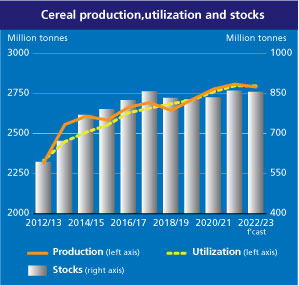
Rome: Ukraine, the grain basket of the world, is now among a list of 46 countries including Sri Lanka, which are in need of external assistance for food. The list includes 33 countries in Africa, 10 in Asia, two in Latin America and the Caribbean and one in Europe, according to the latest Crop Prospects and Food Situation Report, released today by the Food and Agriculture Organization of the United Nations (FAO’s) Global Information and Early Warning System (GIEWS).
The report says that the war has resulted in significant numbers of displaced persons in Ukraine. It informs that Sri Lanka is experiencing a multidimensional crisis that has led to high prices and severe shortages of essential products. Serious concerns also relate to East Africa which faces a looming risk of famine in some areas. Here persisting rainfall deficits and multiple seasons of drought conditions, are sharply curbing production prospects and have already caused extensive animal deaths in 2022, with severe food insecurity implications, particularly for pastoralists.
In West Africa too, production prospects are uncertain for the 2022 crop, reflecting worsening conflicts and an uneven start of the rainy season, according to the report. In Asia, dry weather conditions curbed yields of 2022 crops in the Near East, while mixed weather conditions are tempering production expectations in CIS Asian countries. In Central America, unfavourable weather conditions and high costs of agricultural inputs had a negative impact on the 2022 cereal production outlook.
However, in Far East Asia area expansions are driving up production prospects and the aggregate 2022 cereal output is forecasted above the five-year average. Similarly in South America, a bumper maize output is forecast in 2022 underpinned by large plantings, while there are some concerns for the 2022 wheat crop due to drier–than–normal weather conditions.

Across the globe, though, the report says, the rising food prices and overall inflation are worsening food security conditions, particularly in low-income food-deficit countries, while the use of agricultural inputs could be limited by their elevated prices, possibly lowering yields and harvests in 2022.
 Crop Prospects and Food Situation report is complemented by the Cereal supply and demand balances for sub-Saharan African countries, which was released simultaneously today. Its forecast for global cereal production in 2022 has been raised by 7 million tonnes in July from the previous month and is now pegged at 2,792 million tonnes, however, still 0.6 per cent short of the world output in 2021. The forecast for world cereal utilization in 2022/23 has also been lifted, up 9.2 million tonnes to 2, 797 million tonnes, but is still 1.7 million tonnes (0.1 per cent) below the 2021/22 level, mostly reflecting lower feed use.
Crop Prospects and Food Situation report is complemented by the Cereal supply and demand balances for sub-Saharan African countries, which was released simultaneously today. Its forecast for global cereal production in 2022 has been raised by 7 million tonnes in July from the previous month and is now pegged at 2,792 million tonnes, however, still 0.6 per cent short of the world output in 2021. The forecast for world cereal utilization in 2022/23 has also been lifted, up 9.2 million tonnes to 2, 797 million tonnes, but is still 1.7 million tonnes (0.1 per cent) below the 2021/22 level, mostly reflecting lower feed use.

FAO’s forecast for aggregate cereal production of Low-Income Food-Deficit Countries (LIFDCs) in 2022 is pegged at 187.8 million tonnes, a marginal increase compared to the five-year average and the previous year, the report said.
Meanwhile, the barometer for world food commodity prices declined slightly in June for the third consecutive month, FAO reported today.



The FAO Food Price Index, a measure of the monthly change in international prices of a basket of food commodities, averaged 154.2 points in June 2022, down 2.3 per cent from May 2022. The Index, which tracks monthly changes in the international prices of a basket of commonly-traded food commodities, remained, however, 23.1 per cent higher than in June 2021. The drop in June 2022 reflected declines in the international prices of vegetable oils, cereals and sugar, while dairy and meat prices increased.
– global bihari bureau





